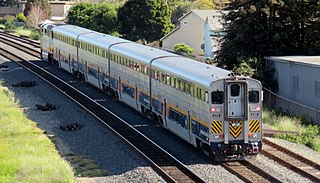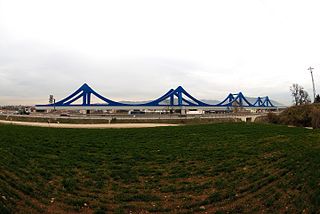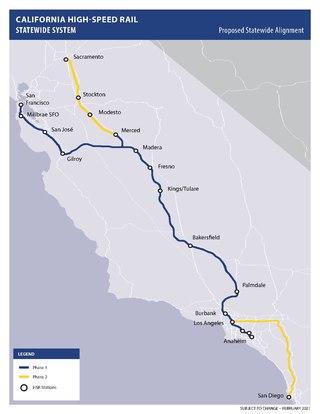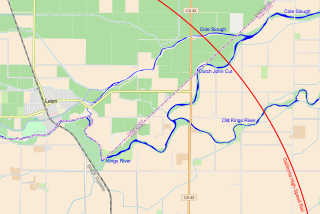
The San Joaquins is a passenger train service operated by Amtrak in California's San Joaquin Valley. Six daily round trips run between its southern terminus at Bakersfield and Stockton, with onward service to Sacramento and Oakland.

California High-Speed Rail is a publicly funded high-speed rail system being developed in the U.S. state of California by the California High-Speed Rail Authority. It was authorized by a statewide ballot proposal called Proposition 1A. It is intended to reduce travel times in the state, particularly between the major urban areas of the north and the south. The system is also intended to reduce pollution and carbon emissions, ease highway and air traffic congestion, and boost the state's economy, particularly in the Central Valley region.

The Fresno River is a river in Central California and a major tributary of the San Joaquin River. It runs approximately 83 miles (134 km) from the Sierra Nevada Range to the San Joaquin River if measured from the source of Rainier Creek, near Raymond Mountain in Yosemite National Park. Although called the 'Fresno' River, it is one of the largest and longest river systems in Madera County.

The Santa Fe Passenger Depot, also known as Fresno station, is an historic railroad station and transportation hub in downtown Fresno, California. It is served by San Joaquins inter-city passenger trains, Greyhound inter-city buses, and regional transit services including Fresno Area Express and the Fresno County Rural Transit Agency.

San Bruno station is a Caltrain station located in San Bruno, California. The station is located just northeast of downtown San Bruno, above the intersection of San Mateo and San Bruno Avenues, adjacent to Artichoke Joe's Casino.

Wasco station is an Amtrak station on the San Joaquin located in Wasco, California, United States. The station has one platform on the west side of a single track.

The Sant Boi Bridge is the first steel structure in the high-speed railway joining the city of Madrid and Barcelona.

The Llinars Bridge this bridge is the first steel structure in the high-speed railway (HSR) joining Barcelona and the French Border. The 1,883-foot-long (574 m) Llinars HSR bridge comprises two parts: a 1,008-foot-long (307 m) composite steel–concrete structure crossing Autopista AP-7, and a continuous prestressed concrete bridge crossing the Mogent River with a maximum span of 157 feet (48 m).

The construction of the California High-Speed Rail system is an undertaking by the California High-Speed Rail Authority. The project is expected to span about 800 miles (1,300 km) and will be completed in two phases:

The California High-Speed Rail Authority was established in 1996 after decades of advocacy for building a high speed rail system in California. The passage of Proposition 1A in 2008, followed by the awarding of federal stimulus funds in 2010, established the initial funding for the California High-Speed Rail system. Construction contracts began to be awarded in 2013, and the groundbreaking ceremony for initial construction was held on January 6, 2015.
Bakersfield station is a proposed California High-Speed Rail station in Bakersfield, California. The station is part of the initial construction segment.
Kings–Tulare Regional Station is a planned California High-Speed Rail station serving Kings County and Tulare County, California. It will be located near the intersection of Hanford Expressway and Central Valley Highway, just east of the city limits of Hanford and less than 20 miles (32 km) west of the larger city of Visalia. The construction of the station has been controversial, with Tulare County supporting the station while Kings County, where the station would be located, has strongly opposed the entire California High-Speed Rail project.
Merced station is a proposed California High-Speed Rail station in Merced, California, located in Downtown Merced. The environmentally approved site is on Martin Luther King Jr. Way near the interchange with Route 99/59, placing it about 7 blocks south from the existing Merced Amtrak station. The station was initially intended to be the northern terminus of the system's Initial Construction Segment. As of April 2022 the California High-Speed Rail Authority is studying an alternative location proposed by the City of Merced and other stakeholders, 8 blocks to the west-northwest along 15th Street, between O Street and R Street. The high-speed rail line will run on the south side of the Union Pacific Railroad right-of-way at these locations.

The Fresno River Viaduct is a bridge to carry California High-Speed Rail over Route 145, the Fresno River, and Raymond Road in Madera County, California.

The California High-Speed Rail system will be built in two major phases. Phase I, about 520 miles (840 km) long using high-speed rail through the Central Valley, will connect San Francisco to Los Angeles. In Phase 2, the route will be extended in the Central Valley north to Sacramento, and from east through the Inland Empire and then south to San Diego. The total system length will be about 800 miles (1,300 km) long. Phase 2 currently has no timeline for completion.
Madera station is a proposed train station to serve Madera, California. It would be located near the intersection of Avenue 12 and Santa Fe Drive.

The Kings River Viaduct is a planned series of bridges and embankments carrying California High-Speed Rail over the Kings River in Fresno County and Kings County, California. The site is between the Fresno and Kings–Tulare stations, roughly 4 miles (6.4 km) east of Laton and 8 miles (13 km) north of Hanford. The structure is planned to be over 2 miles (3.2 km) long because three river channels must be crossed, two of which were created by floods in the 1860s.
The Pacheco Pass Tunnels are a planned set of tunnels to carry California High-Speed Rail across the Diablo Range in the vicinity of Pacheco Pass east of Gilroy, California. The tunnels will constitute the first mountain crossing constructed as part of California High-Speed Rail, connecting the San Francisco Bay Area and Central Valley portions of the system.

The Stockton Subdivision is a railroad line in the U.S. state of California owned by the BNSF Railway. It runs from the Port of Richmond, where trains interchange with the Richmond Pacific Railroad, to Fresno where the railway continues south as the Bakersfield Subdivision or the Union Pacific Fresno Subdivision. The line was originally constructed by the San Francisco and San Joaquin Valley Railroad in the late 1890s before being acquired by the Atchison, Topeka and Santa Fe Railway and becoming its Valley Subdivision. BNSF spent $17.5 million to upgrade track, bridges, and crossings along the line in 2005.

In addition to the direct reduction in travel times the HSR project will produce, there are also economic and environmental impacts of the high-speed rail system. These were also specifically noted in Proposition 1A at the time the project sought authorization from the voters of the state in 2008. The anticipated benefits apply both generally to the state overall, as well as to the regions the train will pass through, and to the areas immediately around the train stations.
















